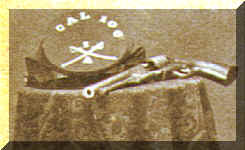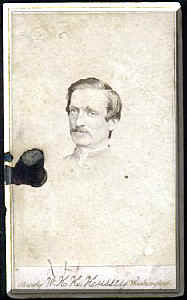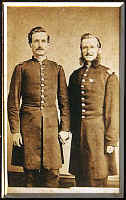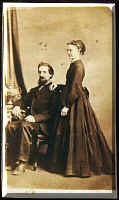|
William Henry Harrison Hussey
Co.s A, C & I, Second Massachusetts Cavalry 1862 - 1865
 |
 |
 |
 |
 |
His cap and Colt
Army
click to enlarge |
As a
private |
w/ brother David
(see below) taken in March 1865 |
w/ wife Abigail c.
1868 |
contributed by Michael Fitzpatrick (descendent)
Born in Ohio during the election year of 1840, William Henry Harrison Hussey
was named for the leading presidential candidate. In the early 1850s his family
moved to Delaware County, Iowa. By the time he was a teenager, Will Hussey
exhibited an adventurous spirit. In 1858, at the age of 18, he left his Iowa
home to follow an older brother to the west coast. Traveling first to New York,
he journeyed from there by sea down the Atlantic, then across the Isthmus of
Panama and up the Pacific coast to California. He tried his hand unsuccessfully
at mining in the Sierra gold fields. That winter he, along with two friends and
a dog, was caught in a mountain blizzard that quickly obliterated all traces of
the trail. Stumbling through the snow for five days, the men had "nothing
to eat save poor ‘Poison’ – which was the dog’s name – who was
sacrificed to satisfy the cravings of his masters."1
After giving up gold mining, Will Hussey took a job as a ranch hand until the
Civil War erupted in the East, thus presenting an opportunity that would not
only "test his loyalty to his country but also his courage and
endurance."2 On October 27, 1862, the governor of
Massachusetts exchanged telegrams with certain men in San Francisco authorizing
the recruitment of a company of one hundred California cavalrymen. The next day
recruitment began for a "Cavalry Company for the East" and
according to a San Francisco newspaper ad, "No one need apply who is not
a good horseman and in good health. Men from the country preferred."3
Will Hussey enlisted on October 30. In three weeks over five hundred men had
offered themselves, but only the one hundred best horsemen were selected. The
one hundred picked men were mustered into the service on December 10, 1862 and
proudly called themselves the California Hundred. These expert horsemen would
eventually claim, with some justification, that they could out-ride anyone in
either the Yankee or Confederate armies.
On December 11 the men left San Francisco on the steamer "Golden Age"
bound for the East via Panama. After an overland passage by train across the
isthmas, the men boarded a different ship on the Atlantic side and arrived at
Readville, Massachusetts on January 4, 1863. There they became Company A of the
Second Massachusetts Cavalry and joined several companies made up of men from
Massachusetts. In February the first battalion of the Second Massachusetts
Cavalry was sent to Gloucester Point opposite Yorktown, Virginia, where Will
Hussey "was here instrumental in making the first capture of the
notorious guerrilla captain, Allen, and his two orderlies at the Blackhouse
plantation near Lower Guinea."4
On June 1, Will was promoted to corporal. On June 26 the Second Massachusetts
participated in a march to Hanover Court House where they captured a rebel
supply train, burned the bridge over the South Anna River and "after two
hours hard fighting, [succeeded in] killing and taking prisoners some
seventy-five of the Fifteenth South Carolina Infantry."5 In
July 1863 the regiment was transferred to northern Virginia and was brought up
to full strength with the addition of four more companies from California known
as the California Battalion.
Near Aldi, Virginia on July 30 the men of the newly-arrived California
Battalion had a brush with the Partisan Rangers under John S. Mosby and
recaptured thirty-three sutler’s wagons filled with supplies that the
confederates had taken a few days earlier. Mosby considered the Californians
with the Second Massachusetts Cavalry to be his most formidable opponents. He
later recalled the incident in these words: "At one time I captured a
lot of very richly loaded wagons in sutler’s train. I thought at first of
burning them, but finally concluded to carry them off. It was about twelve miles
to a place of safety in the mountains and while on the way we met a part of the
Second Massachusetts Cavalry. The California Hundred and Battalion was a part of
the regiment we came against. They were a fine body of men and the most cheerful
fighters I ever met. Well, I was obliged to leave the wagons behind and the
sutlers got them back again."6
During the remainder of 1863, the Californians had several running fights
with the Partisan Rangers and the winter of 1863-1864 passed with the men
guarding a line of 30 or 40 miles. But chasing after rebel guerrillas was
unsatisfactory duty for the Californians who yearned for the opportunity to
prove their mettle against regular confederate troops. Will Hussey was promoted
from corporal to sergeant on January 25, 1864. Towards the end of March he
became sick and spent some time recuperating with relatives in Uniontown, Iowa.
By May he had returned to his regiment and on June 20 he was promoted again;
this time to first sergeant.
Following the battle of the Wilderness, the Second Massachusetts Cavalry
accompanied an ambulance train deep into confederate territory to evacuate the
wounded Union soldiers left behind when the armies moved on after the fight. In
July 1864 the regiment was placed in front of the Union defenses protecting
Washington, D.C., from the sudden advance of a large force of confederates under
Major General Jubal Early. Early pushed his way to Fort Stevens within a few
miles of the federal capital before being dislodged and forced to retreat.
The Second Massachusetts Cavalry and a few hastily assembled smaller groups
of men from other regiments were the only mounted cavalry troops in the vicinity
and started at once to pursue the enemy. On July 13, 1864 they came across the
rear of Early’s army at Rockville, Maryland where a fierce skirmish broke out
in the center of town. Opposed by enemy infantry and cavalry, the men of the
Second Massachusetts finally had their chance against confederate regulars.
Repulsing three separate charges against their position, the Californians "stubbornly
held their own against a numerically superior foe, earning a solid reputation
for toughness."7
On July 19, 1864, less than a week after the Rockville fight, Will Hussey was
commissioned and promoted to second lieutenant. Because the regiment was short
on officers he was given command of Company C (but due to the almost daily
contact with the enemy for the next several months and his subsequent wounding,
he was unable to be officially mustered in at his new rank until January 1865).
During the late summer and fall of 1864 the regiment was in the Shenandoah
Valley of Virginia. Will Hussey was in action in all the fights in the valley
including Halltown, New Market, Winchester, Fishers Hill and had his horse shot
from under him while charging the rebels at Waynesboro.
On October 19, 1864, under cover of a thick fog, Confederate forces under
General Early surprised the Union army in camp near Cedar Creek. The Second
Massachusetts Cavalry had discovered the movements of the rebels on the Union
right before daylight and was able to hold this portion of the line until
relieved by infantry. The cavalry was then ordered to the left to oppose the
enemy there and made a remarkable parade-ground march between the lines while
under fire. The troopers then dismounted and advanced under a heavy fire to a
strong position behind a stone wall. The enemy made several attempts to dislodge
them with infantry assault columns and artillery but failed. Sometime during
this fight, and while in command of Company C, Will Hussey received a severe gun
shot wound in the left shoulder. The bullet entered from the front, fractured
his collar bone, and passed backwards before lodging near the shoulder blade.
Will Hussey was evacuated to a field hospital at Winchester, Virginia, but
due to the large number of wounded men following the battle, he spent five days
lying on the ground before being sent on to the Post Hospital at Martinsburg,
West Virginia. At some point along the way the bullet and several pieces of
splintered bone were extracted. On November 13, he applied for and received a
twenty day leave of absence in order to recuperate at home in Iowa. Afterwards
he reported to Armory Square Hospital in Washington, D.C., and from there was
sent to the officer’s hospital at Annapolis, Maryland where he was admitted on
December 20, 1864. His hospital records at Annapolis indicate there were "still
some fragments of dead bone remaining in [the] wound, keeping up an irritation,"
but the records went on to say that the "wound don’t require much
treatment."8 On December 21 he had a dry lint dressing
applied to the wound, and had a simple dressing applied again on December 26.
On January 5, 1865 Will returned to duty and reported to the remount camp
near Harpers Ferry where he was finally mustered as second lieutenant to date
from January 1. Still partially incapacitated, he was detached as acting
Quartermaster and Commissary for the Sixth and Seventh Michigan Cavalry. In this
capacity Will was eventually detailed to the Point of Rocks supply depot,
located on the north bank of the Appomattox River near Petersburg, Virginia.
In March 1865 Will spent several days with his younger brother, first
lieutenant David J. Hussey (Co. D, 174 Ohio), who was then recovering from
illness in Washington, D.C. In a letter to his cousin, David wrote that he
"just happened to come across [Will] after he had been in the City three
days. Then didn’t we have one glorious time while he stayed. We were together
four days and had a good time generally... until the hour came for him to
leave..." The near hero-worship that David had for his older brother
shows through in his letter when he wrote, "I just think Will is a
perfect being in all respects. He is so kind so noble so affectionate so
everything that we so much love in young men."9
Due to continued stiffness in his shoulder, Will was not able to rejoin his
own regiment until the close of the final campaign at Appomattox Court House. In May
1865 he and his regiment participated in the Grand Review of the army in
Washington D.C. This two day long celebration paraded over a hundred thousand
troops of General U. S. Grant’s Army of the Potomac and General W. T. Sherman’s
Army of Georgia and Army of the Tennessee past the citizens and government
officials in the Nation’s capital. On June 20, Will Hussey was promoted and
mustered as first lieutenant of Company I. He was subsequently promoted to
captain but was not mustered at that rank before being discharged on July 20,
1865 at Fairfax Court House, Virginia.
After the war, Will Hussey married Abigail Way of Noble County Ohio. He
taught school for a few years in Ohio and Illinois before moving with his family
back to California in 1869. He worked in Oakland as a bookkeeper of customs for
a number a years and later as a manufacturer of blasting powder. He died on
February 11, 1914 and was buried in a private ceremony at the National Cemetery
at the Presidio in San Francisco.
Notes:
1. History of Alameda County, California, 1883
2. ibid.
3. Undated clipping from a San Francisco Newspaper, 1862
4. History of Alameda County, California, 1883
5. ibid.
6. Backus, Samuel W., 1889, Californians in the Field Historical Sketch of the
Organization and Service of the California
"Hundred" and "Battalion," 2d Massachusetts Cavalry.
7. Fitzpatrick, Michael F., Jubal Early and the Californians, in Civil
War Times Illustrated, May 1998
8. United States Archives, Pension Records
9. Letter from David J. Hussey to his cousin Julia C., dated Seminary Hospital,
March 14, 1865.
|




